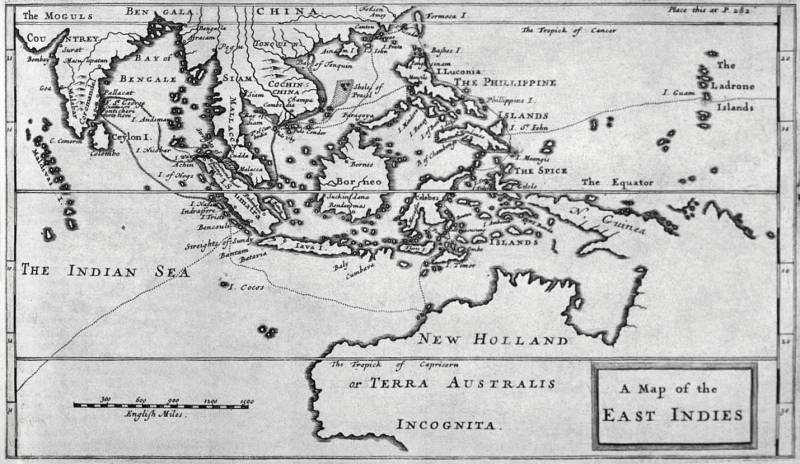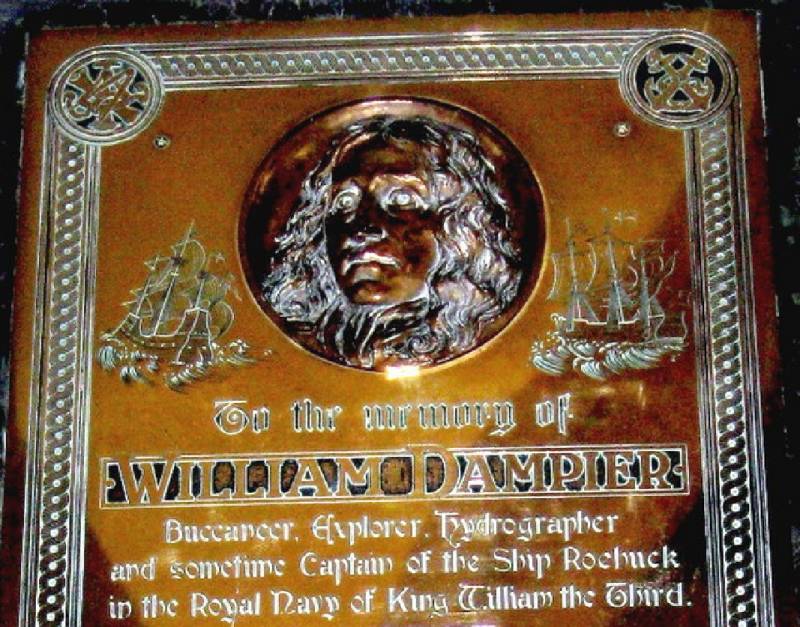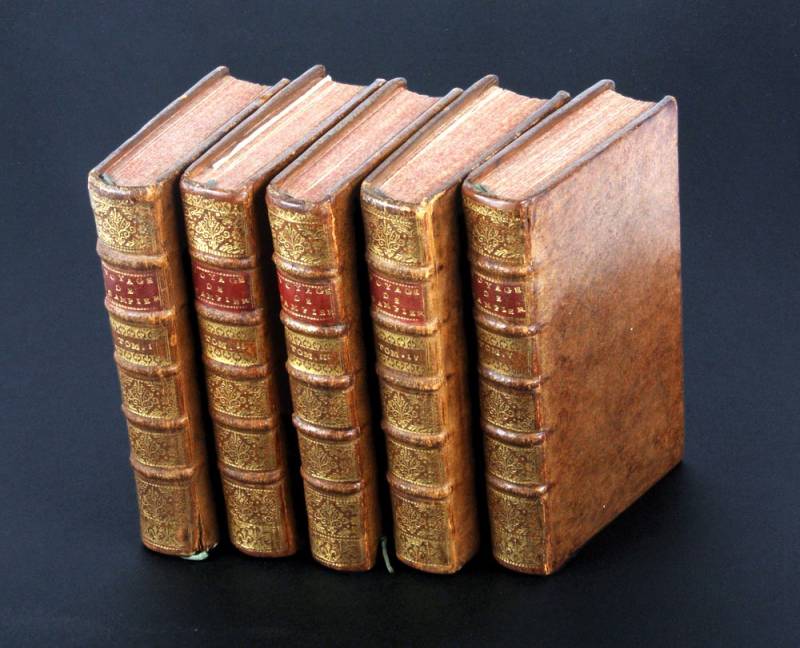Adventurer and adventurer Dampier. Part of 2
Second time around the world
Career Dhampir developed rapidly. He was a welcome guest in the homes of the powerful. For example, William attended a dinner with the famous and influential writer John Evelyn at the time. And the company was made by the secretary of the British Admiralty Samuel Pips.
This is how Evelyn told about that meeting with an adventurer: “Now he is again going to sail with the support of the king, who equipped the ship with a displacement of 290 tons. He gives the impression of a more modest person than one would imagine, given the environment to which he belonged. He brought a map of the directions of the winds of the South Seas, compiled from his observations, and assured us that such maps, which had hitherto existed, were all wrong in the part related to the Pacific Ocean. ”
It was on that ship that Evelyn recalled that Dampier sailed away without waiting for the release of his second book. The vessel, bearing the name "Roubak", went to the shores of Australia (then - New Holland) and New Guinea.
But the beginning of the voyage was difficult. The fact is that Dampier did not get along with the character of Lieutenant George Fisher, who held the position of navigator. William reproached him for being unprofessional, and George, in turn, was outraged that he was led by a former pirate.
Up to a certain point, the men restrained themselves, but when Roubak headed from West Africa towards Brazil, they broke loose. This is how Dampier described the incident in his diary: “I was insulted daily by my lieutenant George Fisher. When Fisher’s behavior became completely unbearable, I threatened him with a cane, which was then in my hands, to which he turned to me, called me an old dog, an old villain, and told my people: “Gentlemen, grab this old pirate dog, for he intends to run away with you and the royal ship. " Therefore, he was put under arrest to prevent him from causing a riot on the ship. ”
By the way, at that time, William was “already” forty-eight years old. Dampier could not tolerate such an insult. Therefore, the rebel drove the rebel into the cabin and locked it there. Fisher stayed locked up until the ship reached the shores of Brazil. Here Dampier passed his navigator into the hands of the Portuguese governor, who put the rebel behind bars.
"Roubak" not long stayed on the Brazilian coast. Having replenished supplies of provisions and water, the ship headed for the Indian Ocean. In early August, Dhampir and his team reached Australia. Here, William surveyed the coastline for several hundred kilometers. Then he came across a group of islands, which later became known as the Dampier Archipelago.
Then "Roubak" looked "to visit" to Timor, the western coast of New Guinea and Mussau. And when William reached the shores of the island of New Ireland, he was sure that he was near the northern part of New Guinea. Because of this, the adventurer considered the St George Channel Strait by the bay. Dampier did not imagine that he was separating New Ireland from New Britain.
Also during the voyage, the adventurer discovered the strait between the very same New Britain and New Guinea. He, by the way, was also named after the traveler. When the “Roubak” reached Batavia, Dampier decided to roll out a research expedition and headed back.
In February, 1701, the ship suddenly began to flow. The team had to urgently look for a way out of the catastrophic situation - near the Ascension Island, “Roubak” literally began to sink. Since there was only one exit, Dampier put the ship on the coastal bank.
For more than a month, William and the sailors had to spend on Ascension Island. But they were still very lucky, because the food they served was the meat of wild goats and turtles. And this turned out to be surprising for the British, because at that time it was believed that this island was devoid of fresh water, which means it was completely uninhabited. It was Dhampir who became the first European to find the source.
All this time Dampier put his records in order. Here is how he described a volcanic eruption that occurred on one of the islands: “All night the volcano spewed fire and smoke, which was accompanied by a terrible noise like thunder, and there was a flame, worse than which I had not seen ... Then you could see a huge stream of fire, running to the foot of the volcano and even almost to the shore. "
And here is how an adventure seeker told about the Aborigines, whom he happened to meet during a short landing on the land: “A quick young man who was with me, seeing them close, ran after them, and they immediately rushed to run away from him. He had a sword, and they had wooden spears. There were a lot of them, and he had a hard time. Initially, when he ran after them, I chased the other two, who were near the shore, but, realizing what could happen to the young man, I quickly turned back, climbed to the top of a sandy hill and saw him not far from myself, surrounded by them. Seeing me, one of them threw a spear flying past me. I shot just to frighten them, not intending to kill anyone. Although the shot at first frightened them a bit, they soon calmed down and, throwing up their hands, shouting contemptuously, “poo, poo, poo”, approached us again. I realized that we must act decisively, and shot at one of them. The others, seeing that he fell, retreated, and the young man was able to break free and come running to me. The other person who was also with me could not help because he did not have weapons. I returned with my people, leaving an attempt to capture any of the natives, being upset by what had happened. The natives took with them a wounded comrade. And my young man, who was wounded by a spear on the cheek, was very afraid that the spear was poisoned, but I did not think so. His wound was very painful, as it was inflicted with a blunt weapon, but he soon recovered. ”
Do not forget William to mention the medical tricks used by Aboriginal people. This is how he was cured of his illness: “I was buried to the very head in the hot sand, I kept it for half an hour, after which I was dug out and put to sweat under a tarp. I was sweating a lot all the time while I was sitting in the sand, and it looks like it did me good, because very soon I felt better. ”
In early April, English flotillapassing by Ascension Island noticed an abandoned ship and smoke. Thus, Dampier and his sailors were saved.
William reached his native England only in August 1701 of the year. True, this return cannot be called triumphant. Yes, he was already considered a glorified and fearless explorer of unknown lands, but ... Not only fans but also the Admiralty court were eager to meet Dumpier. The fact is that Fisher, whom William had already safely forgotten, had left the Brazilian prison. And the first thing he charged against his former commander.
The case was considered a little less than a year. And in early June 1702, a trial took place. It is curious what was happening this "action" on board the ship "Royal Sovern". After examining the arguments and evidence of both parties, the court decided to find Dampier guilty of excessively cruel treatment of Fisher. This was the verdict text: “After thoroughly examining all the points of accusation put forward by Captain Dampier and Lieutenant Fisher against each other, the court found that many of them were, in fact, insignificant, and others were not sufficiently proven. Thus, the main case, which was considered by the court, was the cruelty of Captain Dampier against Lieutenant Fisher. The fact that he beat his lieutenant, kept him under arrest for many months, then landed in shackles and sent to prison, is undeniably unacceptable. The explanations he gave to justify his actions, references to the information he had about the conspiracy prepared by the aforementioned lieutenant, and the suspicions he had about the lieutenant were not proved by him and remained only speculations and conjectures. By virtue of this, the military court imposes a sentence in favor of the lieutenant. The court further expresses the opinion that the aforementioned captain Dampier is not the person who can be used as commander of any ship of her Majesty’s fleet. ”
Such a verdict meant only one thing - Dhampira was dismissed. And at the same time they hung him a fine of an impressive amount equal to his three annual salaries.
Despite the harsh sentence, the reputation of William, we can say, with dignity withstood the blow. And when a year later his third book came out, Lord Admiral Prince George, who was the husband of Queen Anne, introduced the adventurer to his crowned spouse. Dampier, at that time was about to go on a new journey, but of course he could not refuse to meet with her majesty. And the latest issue of the London Gazette said: “Shortly before going on a new voyage to the shores of the West Indies, William Dampier was honored to attach himself to the hand of Her Majesty.”
By travel, Dampier meant a privateer voyage to the Pacific Ocean. At the expense of foreign ships loaded with valuable goods, he expected to improve his rather disastrous financial situation.
And in the spring of 1703, Dampier went on an expedition aboard the ship "St. George." Soon they were joined by another ship, the Sink Ports galleys-frigate commanded by Captain Charles Pickering.
The ships made a route from the coast of West Africa and the Cape Verde Islands to the intersection of the Atlantic Ocean and sailing along the Brazilian coast. Just near the country, "where there are many, many wild monkeys," Pickering suddenly died. Thomas Stradling became the new captain of Sink Ports, and Alexander Selkirk became his assistant.
After the ships circled Cape Horn, they moved to the island of Juan Fernandez. The team, after such a long and difficult journey, needed a rest. In addition, supplies of fresh water and supplies came to an end.
Saint George and Sink Ports achieved their coveted goal only in February of 1704. For several weeks the sailors rested and gained strength, after which they went out, so to speak, to hunt. Their victims were mostly French and Spanish ships. But the prey was constantly too scarce. Then the British decided to plunder the city of Santa Maria, who was in the Isthmus of Panama. But even here the robbers were expected to fail. The governor of Panama was expecting the appearance of robbers, so he sent several hundred professional soldiers to the city. The Spaniards attacked from ambush, and the British had to retreat with a fight.
Tired and disappointed, the sailors returned to their ship. And then they were suddenly smiled by luck: they saw a Spanish ship anchored. His English easily captured and divided the rich booty. After this success, Dampier and Stradling decided that it was better for them to act alone.
Thomas headed for the Juan Fernandez Islands. There he quarreled with Alexander Selkirk, his assistant, ordered to leave the unfortunate on the shore ...
As for Dhampir, he robbed foreign merchant ships for some time. There was only one significant success - the British managed to seize the barque. This large sailing ship was given the name "Dragon", and its captain was John Clipperton. True, this tandem did not last long. A few months later, Clipperton, having stolen the letter of marquets, equipment and supplies, escaped from Dampier.
William had no choice but to accept it. Having repaired St. George, he began to hunt for a galleon from the Philippines. Therefore, I went to the South Sea. The coveted ship appeared a few months later. But here luck has changed the adventurer. Galleon managed to repel the attack of two British ships.
After the failure was followed by a riot. Of the sixty-two sailors, thirty-five decided to leave Dhampir. William agreed to make concessions, so he gave the “Dragon” rebels, and he went to Guayaquil Bay. Having made several successful raids on coastal settlements, William captured the Spanish brigantine. Her condition was much better than that of St. George. Therefore, Dampier abandoned his old ship and continued sailing on a new one. Brigantine, called "Justification" went to Indonesia. Here the adventurer clashed with the Dutch. He was arrested and put in prison on suspicion of piracy. But William was able to prove that he was not a pirate, but a privateer.
And at the end of 1707, the Englishman still got to the house. So ended his second voyage around the world.
And go again
Dampier could not linger long in one place. He was again attracted by the sea and adventure. And after a short time he went to his third voyage around the world. True, this time, William held the position of navigator, and the expedition was headed by Captain Woods Rogers.
An important event took place in early February 1709. Rogers ships passed by the Juan Fernandez Islands. Suddenly, the sailors noticed smoke streams. The captain decided to check what it was and sent the boat to the land pieces. As soon as the sailors went ashore, a man in goat's skin jumped out to them. When the savage was taken aboard, Dampier recognized Alexander Selkirk in him. The very same one that Captain Streyling left on the islands four years ago. William vouched for Selkirk before Rogers, and he took him to the command of the ship.
During the time spent on the island alone, the poor pirate almost forgot his native language. And only thanks to the efforts of Dhampier and the rest of the team members, did Alexander gradually begin to turn from a savage into a civilized person.
When the ships returned to England, Selkirk met with journalist Richard Steele and told him about his adventure. The journalist in great detail has set out this history in several rooms of the Englishman. Learned about the miraculous rescue of a sailor and the writer Defoe. It was Selkirk who became the prototype of the well-known Robinson Crusoe, the book about which was published in 1719 year.
Dampier lived on land for another three years. He died in the 1715 year, leaving behind only books and debts. All that he earned, as well as the property of his relatives had to pay for the repayment of loans. Where the adventurer and adventurer was buried, unfortunately, is unknown.




Information